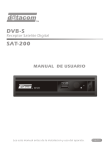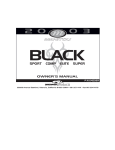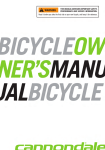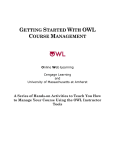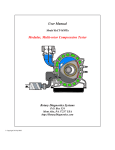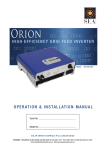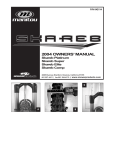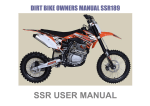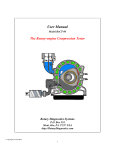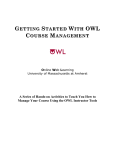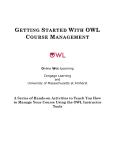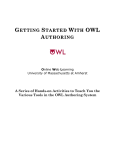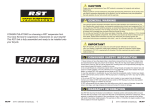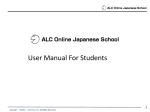Download Bristol Bicycles User Manual
Transcript
Table of Contents Before You Ride..........................................4 Weight Rating...........................................4 Standover Height......................................4 Saddle Height...........................................4 Handlebars................................................6 Check your bike every time you ride........8 Riding.........................................................11 Lighting...................................................11 Helmet.....................................................11 Highway Code.........................................11 Braking....................................................12 Changing gear........................................12 Maintenance and Care..............................16 Free 2-week check-up............................16 Cleaning..................................................16 Lubrication..............................................17 Quick Release Levers.............................18 Brakes.....................................................20 Wheels....................................................24 Tyres and tubes......................................26 Gears......................................................26 Headset...................................................31 Bolt Checks.............................................32 Recommended Tools..............................32 Bicycle Storage.......................................33 Warranty.....................................................34 Limitations...............................................34 Appendix 1: Bolt Torques........................36 Appendix 2: Metal Fatigue.......................37 What to look out for.................................37 Why does fatigue damage happen?.......38 Bristol Bicycles User Manual This manual contains important safety and maintenance information. It is essential that you read it thoroughly before you ride your new bicycle, and keep it for future reference. Please pay special attention to all the points of safety information in this manual, as they are in place to help you avoid serious injury. If you encounter any issues with your bicycle not detailed in this manual, or if you do not understand anything, please cease use of the bicycle immediately and consult Bristol Bicycles. This manual is not intended as a comprehensive service or repair manual. Even if you carry out the maintenance detailed in this manual, your bicycle will still require professional servicing, normally every 6 to 12 months, or sooner in the case of accident, damage, malfunction or heavy use. This manual provides general guidance only; for detailed information please refer to the instructions from individual component manufacturers provided at the time of bicycle purchase. Intended Use Bristol Bicycles are for use on-road and on well-finished, smooth paths and trails. They are not suitable for mountain biking, stunting, jumping, carrying more than one person, or any other purposes. Using a Bristol Bicycle for anything other than the type of riding for which it was designed may result in damage, injury or death. Any non-standard use could also substantially shorten the useful product life of the bicycle. All Bristol Bicycles should be checked annually by a professional bicycle mechanic for indications of potential failures including cracks, corrosion, dents, deformation, paint peeling and any other indications of problems, inappropriate use or abuse. These are crucial safety checks and very important to help prevent accidents, bodily injury or death. SAFETY WARNING: all bicycles are subjected to wear and high stresses. Different materials and components may react to wear or stress fatigue in different ways. If the design life of a component has been exceeded, it may suddenly fail, possibly causing injury to the rider. Any form of crack, scratch or change of colouring in highly stressed areas may indicate that the life of the component bas been reached and it should be replaced immediately. See Appendix 2 for more information. A crash or other impact can place high stresses on bicycle components, causing them to fatigue prematurely. Damaged components can fail suddenly and catastrophically, causing loss of control, serious injury or death. Always get your bike checked by a professional after a crash or collision. Like any form of transport, cycling involves potential risk of injury and damage. While the risk is low compared to many other activities, by choosing to ride a bike you assume the responsibility for that risk, so you need to know and to practice the rules of safe and responsible riding and of proper use and maintenance. Proper care of your bicycle reduces the risk of injury. This manual contains safety warnings concerning the consequences of failure to maintain or inspect your bicycle and of failure to follow safe cycling practices. Many of the warnings say “you may lose control and fall”. Any fall can result in serious injury or even death, so we do not always repeat the warning explicitly. It is impossible to anticipate every riding situation or eventuality, so this manual makes no representation about the safe use of the bicycle under all conditions. Some risks are inherent in the use of any bicycle which cannot be predicted or avoided, and these are the sole responsibility of the rider. 2 3 BEFORE YOU RIDE Weight Rating Bristol Bicycles of all sizes are certified up to a gross weight of 100kg (this is the combined weight of bicycle and rider and any luggage). Standover Height Seatpost too high: unsafe The standover height is the distance from the ground to the top of the bicycle’s frame at the point where your crotch is when straddling the bike. To check for correct standover height, straddle the bike while wearing the kind of shoes in which you will be riding. If your crotch is in contact with the frame, the bike is too large. This cannot be adjusted, and means you require a different size of bicycle frame. You should have a minimum standover height clearance of about two inches (5cm). Saddle Height Seatpost lowered sufficiently: safe A saddle that is too high or too low will make riding uncomfortable and could result in injury. Check the saddle height before riding to ensure it is safe. (On a Bristol Bicycle, your saddle height will normally have been adjusted at the time of purchase. If in doubt, please consult Bristol Bicycles for advice). SAFETY WARNINGS: To confirm the optimum saddle height for you, sit on your bike and lean against a wall. Place your heels on the pedals and pedal backwards a few times. When the pedal is at the bottom of its travel your leg should be straight. If your knee is bent when the pedal is at its lowest position, you need to raise the saddle. If you have to stretch your leg to reach the pedal or if you find yourself rocking from side to side on the saddle in an attempt to reach the pedals at their lowest point, your saddle is too high. Get off the bike and adjust the saddle height, using a 5mm allen key in the seat clamp bolt. Tighten this bolt to 4 Do not adjust the saddle above the safe limit, as marked on the seatpost. The seatpost should be lowered to the point where the limit mark is entirely slid into the bicycle frame, and no mark is visible above the seat clamp. If the seatpost extends from the frame beyond the limit marking the seatpost or frame may break, which could cause you to lose control and fall. Do not slide the saddle forward or backward beyond the limit marks on the saddle rails. If the bike is ridden with the saddle extended too far forward or backward the saddle rails may bend or break, which could cause you to lose control and fall. 5 between 6 and 8 Nm (see Appendix 1). Get back on the bike and try the new saddle height. Repeat the adjustment if necessary. Then try backpedalling with the ball of your foot on each pedal, as normal. In this position your knee should be slightly bent when the pedal is at its lowest point. This is the best saddle height for optimal pedalling comfort and efficient use of your leg muscles. If you are new to cycling, you may prefer to start with a slightly lower saddle, because this can aid stability and make it easier to place a foot on the ground when you stop. However, as soon as you feel safe and confident to raise the saddle, we suggest you do so, using the method outlined above. A saddle which is too low will reduce your pedalling efficiency and can lead to knee pain or knee injury if used for long rides. It is also possible to adjust the angle or tilt of the saddle, and to slide it forward or backwards slightly. To make either of these adjustments, use a 6mm allen key to loosen the clamp bolt directly underneath the saddle. After altering the saddle to the desired position, fully tighten the bolt to between 21 and 23 Nm (see Appendix 1). Handlebars We have designed Bristol Bicycles with fairly high handlebars, and on most models a range of adjustment is possible to suit your personal preferences. Most Bristol Bicycles are equipped with a quill stem which can slide up or down to alter the handlebar height. The quill stem's height can be adjusted by loosening the 6mm allen bolt facing upwards in the centre of the stem. After loosening it approximately 2 whole turns, tap the top of the bolt gently with a hammer to free the internal clamping mechanism. Now the stem and handlebar should be free to move up and down. Once you have repositioned the handlebars to the 6 SAFETY WARNINGS: After any saddle adjustment, ensure that the saddle adjusting mechanism is properly tightened before riding. A loose saddle clamp or seat post binder can cause damage to the seatpost, or could cause you to lose control and fall. A correctly tightened mechanism will allow no saddle movement in any direction. Periodically check to make sure that the saddle adjusting mechanism is properly tightened. Do not adjust the handlebars above the safe limit, as marked on the stem. The stem should be lowered to the point where the limit marking is entirely slid into the bicycle frame, and no marking is visible above the headset (see page 9). If the stem extends from the frame beyond the limit mark, the stem or fork may break, which could cause you to lose control and fall. An insufficiently-tightened stem binder bolt or handlebar binder bolt may compromise steering action, which could cause you to lose control and fall. Place the front wheel of the bicycle between your legs and attempt to twist the handlebar/ stem assembly. If you can twist the stem in relation to the front wheel or turn the handlebars in relation to the stem, the bolts are insufficiently tightened. Changing the stem height can affect the tension of the gear and brake cables, potentially locking the brakes or creating excess cable slack which can make the brakes inoperable or affect gear indexing. If the brake blocks move in towards the wheel rim or out away from the wheel rim when the stem height is changed, the brakes must be correctly adjusted before you ride the bicycle. Check also that the cables are not pulled taut when steering. 7 desired height, ensure they are centred compared to the front wheel, and then fully tighten the 6mm bolt to between 15 and 17 Nm (see Appendix 1). The two large headset nuts on this type of bike are not involved in the adjustment of the stem and should not be loosened. If they become loose, or if the steering action becomes loose or over-tight, please consult a professional mechanic. Quill stem too high: unsafe Some Bristol Bicycles are equipped with a threadless headset and external clamp stem. The height of these cannot be adjusted and requires the addition of a stem adapter if you want to raise the handlebars. Loosening or removing the stem on this type of bicycle will release the headset bearings and could lead to maladjustment or damage of the headset. Please do not attempt adjustment yourself, instead consult a professional mechanic. Check your bike every time you ride Always have a quick check before every ride. If the bike fails any of the checks below, or if you have any doubts, do not ride the bike and seek the advice of a professional mechanic. SAFETY WARNING: failing to properly carry out these checks before each ride and using a bike with loose, faulty or badly-adjusted components could cause you to lose control and fall. Quill stem lowered sufficiently: safe Tyres: check that they feel firm even under hard thumb pressure. It is normal to have to top up the tyre pressures every few weeks. If soft, inflate the tyres to the correct pressure, as written on the side of the tyre. Check the tyres periodically for cuts, cracks and embedded thorns and debris. If you get a puncture out on the road, the simplest thing is to replace the tube, repairing the punctured tube later to keep as a spare. Wheels: Lift the front of the bike off the ground slightly and give the front wheel a 8 Threadless stem: not height adjustable 9 spin. Make sure neither the wheel rim nor the tyre is rubbing on the brake blocks, mudguard or anything else. Then lift the back of the bike off the ground and repeat for the rear wheel. If either of the wheels is buckled badly enough to be rubbing on the brake blocks or frame, do not ride the bike and seek the advice of a professional mechanic. RIDING Quick Release Levers: Always check the quick-release levers before riding. Check both that the lever is in the closed position and fully tight, and that the wheel is fully and symmetrically seated in the frame or fork. Lighting Handlebars and stem: Always have a quick tug on the handlebars, and give them a twist to see if anything has come loose. If the stem, handlebars or grips have become loose, tighten them before setting off. If whilst riding you notice that anything has come loose, stop riding immediately and check it. Brakes: Give your brake levers a firm squeeze and check the brakes are operative. Check that the lever does not travel too far before the brake starts working: it is essential that the brake lever cannot come into contact with the handlebar grip, no matter how hard it is squeezed. Gears: check that the chain is not jammed or stuck, and that the gears have not been shifted accidentally while the bike was stationary. Check that the pedals turn freely without any noises from the chain. As on any derailleur-geared bike check with special care that the derailleur hanger is not bent, and that the rear derailleur cannot come into contact with the spokes of the rear wheel. (Get into the habit of spinning the cranks and pedals backwards one or two turns before each ride. If the chain goes slack or falls off during this test, it is probably a sign that the gears are misaligned or the hanger is bent. It is better to discover this now than whilst riding when it could cause substantial damage or an accident.) 10 Even if you are an experienced cyclist, we recommend you take time to get used to your new bike before using it on a busy road. All bikes have different handling characteristics and you may need a little time to adjust. All Bristol Bicycles come with reflectors already fitted; these are not a substitute for lights. Bright and efficient lights are a legal requirement, and are vital for your safety, if the bicycle is used after dark on any public highway. Lights are not included with the bicycle and must be purchased separately. Helmet Whilst a helmet is not a legal requirement in the UK, wearing one can potentially reduce the risk of head injury, especially at low impact speeds. However, wearing a helmet does not make you invincible: it is no substitute for careful cycling, observing the highway code, and having a safe and wellmaintained bike. We recommend that children and novice cyclists should wear a helmet; experienced adult cyclists can make an informed decision for themselves. Highway Code Always obey the law, and always adhere to the highway code when riding on the road. See www.gov.uk/highway-code Ride defensively, being aware of what other road users are doing, and trying to anticipate situations of potential danger or risk. Riding in the gutter or too close to parked cars is more dangerous than taking your place in the flow of traffic. Be aware that car drivers may not always see or anticipate you, so do your best to be visible and predictable in your 11 behaviour. One-to-one adult cycle training is available in Bristol, often for free. See www.lifecycleuk.org.uk for information. Braking Bristol Bicycles are equipped with very powerful brakes. Apply the brakes smoothly and gradually, and do not grab the levers or squeeze them too hard. The left-hand lever operates the rear brake and the right-hand lever operates the front. Sudden, powerful braking with the left-hand lever can easily cause the rear wheel to skid, which can be difficult to control. Sudden or powerful squeezing of the right-hand lever could cause a front-wheel skid, which is almost impossible to control and will normally either throw you over the handlebars or cause you to fall sideways from the bike. The brakes will be less powerful in wet weather. A wet road or loose gravel will have less traction than dry tarmac, making skidding much more likely. Before the wheels have a chance to skid, ease off the brakes slightly and then reapply. A skidding wheel does little to slow the bike and means you have no steering control. Hard braking will throw your weight forward, so when you apply the brakes extend your arms slightly and move your weight backwards on the saddle. Changing gear Bristol Bicycles have a very wide range of gears for tackling Bristol's hilly terrain. The right-hand shifter operates the smaller rear gears, and the left-hand shifter operates the three large front gears. Each shifter has two levers: a thumb lever under the handlebar to change the gears in one direction, and a finger lever above the handlebar to change the gears in the other direction. As with all derailleur gear systems, you must pedal forwards whilst changing gear, but do not 12 pedal too hard. Ideally you should anticipate your gear changes before you need them, and then keep the pedals spinning whilst changing gear but gently ease the pressure off the pedals for one or two revolutions to allow the gears to change smoothly. Avoid sudden shifts or changing too many gears at once because the chain may hesitate or jam. Plan ahead and change into an easy gear before coming to a stop. Do not change gear whilst the bicycle is stationary or whilst not pedalling. Do not backpedal whilst changing gear, nor immediately afterwards. For normal, fairly flat terrain we suggest you set off with the left-hand shifter in number 2, and the right-hand shifter somewhere in the middle of its range, around gear 3 or 4. As you accelerate or try a gentle downhill slope and find your legs spinning faster, you can change the right-hand shifter to a higher gear. As you slow down again, change the right-hand shifter to a lower gear again before coming to a stop. Now try a gentle uphill slope. You may find that gear 3 or 4 is too difficult. If so, change into a lower gear on the right-hand shifter: gear 2 or even 1 will make the hill easier. In this way, flat terrain and gentle uphill and downhill slopes can be tackled easily. For a steeper uphill gradient you may find that even gear number 1 on the right-hand shifter does not make the hill easy enough. In that case, also shift the left-hand shifter into gear 1. With both shifters now displaying gear 1, the bike is in its lowest gear and should make even the steepest hills possible. When the left-hand shifter is in gear 1, do not change the right-hand shifter into a gear higher than 4 or 5. On a long, fast downhill gradient you may find that even the highest gear on the righthand shifter is not enough when the left-hand shifter is only in gear 2. In that case, shift the left-hand shifter into gear 3. With the shifters 13 now displaying gears 3 and 8, the bike is in its highest gear. Don't forget to change back into a lower gear before slowing down or coming to a stop, as setting off in top gear can be very difficult! With the left-hand shifter in gear 3, do not change the righthand shifter into a gear lower than 3 or 4. Below chain is on middle chainring and middling sprocket: good Opposite page, top chain is on large chainring and largest sprocket: avoid Opposite page, bottom chain on small chainring and smallest sprocket: avoid 14 15 MAINTENANCE AND CARE We strongly recommend 6-monthly safetychecks and 6-monthly or annual servicing by a professional bicycle mechanic, in the interests of your safety and the longevity and reliability of the bicycle. If you notice anything untoward in the intervening period, again we recommend seeking professional advice. In addition to this professional servicing, it is normal for any bicycle to require regular cleaning, checking and small adjustments. Free 2-week check-up On a new bicycle it is normal for things to 'settle in' during the first few rides. Cables can stretch a little, or brakes can sometimes develop a squeal, for example. All Bristol Bicycles come with a free tune-up within the first 2 weeks of ownership to give you a chance to ride the bike a few times and then have these adjustments and checks made. Please call to book your Bristol Bicycle in for a free check-up and adjustment. This check is limited to the original purchaser and it is only available within the first two weeks of ownership. It is the owner's responsibility to ensure the bike is booked in and returned for the check-up within this period. Proof of purchase may be required. Cleaning Cleaning your bike is important: car shampoo or diluted bike chain degreaser using a sponge and soft brush. Rinse with clean water and allow to drip-dry. To protect the frame and fork and make them easier to clean next time, polish all paintwork with wax car polish using a soft cotton cloth. Clean the chain and gears with a waterbased bicycle chain degreaser – we have found Fenwicks FS-1 to be most effective – using a small brush. For best results, clean the chain with a dedicated cleaning tool – we recommend the Park Tools Cyclone CM-5.2 as being very effective, and more robust than most. Lubrication Several types of chain oil are available. Conventional 'wet' oil is a good choice but attracts dirt if too much is applied. 'Dry' oil evaporates after it is applied, leaving a lowfriction coating (e.g. Teflon) on the chain. This stays clean but is easily washed off so must be reapplied often and is best for dry weather use. For most users we recommend a conventional 'wet' bicycle chain oil. The chain is the part of a bike that will require oiling most often: depending on usage, we recommend weekly, every couple of weeks, or monthly. Before oiling the chain, wipe off any dirt: hold a rag around the lower length of chain and turn the pedals backwards by hand, thereby pulling the moving chain through the rag. A clean and lubricated bike is faster and more efficient to ride. Then apply oil sparingly: again, use your hand to backpedal whilst continuously applying a small amount of oil to the moving chain, avoiding the wheel rims and brakes. The aim is to lubricate the entire chain with a minimum of oil. There is no need to oil the cogs. Then take a clean rag and lightly wipe the chain to remove surface oil: lubrication is only required inside the chain links, excess oil is counter-productive as it will attract dirt. Clean the frame and wheels with a bike or Every 3 months or 500 miles we recommend A bike kept in good, clean condition is likely to last longer and hold its value. Regular cleaning gives you the opportunity to spot any damage, loose components and wear-and-tear before it becomes a problem. 16 17 lubricating the following with a small amount of conventional bicycle chain oil: All derailleur pivots, front and rear V-brake arm pivots Brake lever pivots All brake and gear cables Quick-release cam mechanisms Every 6 to 12 months we recommend having your bike professionally serviced. This should include lubrication of the following with anti-seize grease: Seatpost and quill stem (to prevent them seizing in place). Adjustable stem hinge mechanism (to prevent it creaking or becoming worn). Every 12 months or 2,000 miles, whichever occurs sooner, we recommend getting the headset and wheel bearings rebuilt professionally with good quality automotive, marine or bicycle bearing grease. Quick release lever open: do not ride Quick Release Levers A quick release mechanism is not a nut and bolt type of fastener. It uses a cam action: the amount of clamping force is controlled by the adjusting nut, and the lever is only used to open or close the cam device. Having undone the cam lever, turning the adjusting nut clockwise will increase the clamping force when the lever is re-closed. Turning the nut anti-clockwise will decrease the amount of clamping force when the lever is re-closed. The nut must be adjusted so that the lever starts to present some resistance when halfway (i.e. at 90 degrees to its closed position), and becomes fully tight in the closed position. Fully tight means that it should require very strong hand pressure to close or reopen. If in doubt, cease use of the bicycle and ask Bristol Bicycles to show you the correct method. 18 Quick release lever closed: safe to ride provided the nut is correctly adjusted and the lever is fully tight 19 Whenever you open or adjust the quick release levers, always ensure that the wheels are re-installed fully into the bicycle frame or fork and are sitting centrally before re-closing the quick release levers. Every 3 to 6 months, open each quick release lever, drip a couple of drops of chain oil into the cam mechanism at the base of the lever, and then check and re-close the lever. This will prevent it from rusting and will ensure smooth action and easier use. Closed noodle: safe to ride Brakes Bristol Bicycles are equipped with ‘direct pull’ brakes, commonly known as V-brakes. To disconnect the brakes for wheel removal, release the curved metal tube (the lead pipe or noodle) from the slotted holder on the brake arm. To do this, grab both brake arms with one hand and squeeze them together, onto the rim. There should now be enough slack in the cable to unhook the noodle pipe from its holder, allowing the brake arms to open for wheel removal – if not, use the barrel adjuster on the brake lever to add a little slack, but remember to re-adjust this before riding. Opening the noodle To reconnect the brake, squeeze the brake arms together and hook the noodle pipe back into the holder. Make sure that the noodle pipe is correctly located and that the outer cable is properly seated at both ends (it can ‘pop out’ of the brake lever when slack, and not pop back in when re-assembled). Brake blocks are consumable items and wear out with use. As they wear, the brake levers will travel further before the brake operates, and must be adjusted before the levers are able to come into contact with the handlebar grip. You can take up this cable slack with the barrel adjuster on the brake lever: turn the adjuster a few turns anticlockwise and then check the brake lever travel again. Also check the blocks and make 20 Open noodle: do not ride 21 sure they are not worn out, or worn unevenly. Uneven pad wear may create ridges that can cause the pad to get stuck against the rim, or could cause the block to rub on the tyre causing instant damage. Each brake block is marked with a safe limit line or wear line. Once the brake blocks have worn down to this mark, they must be replaced immediately. Use only good quality brake blocks of the correct type. Observe the correct position and order of the washers and shims. Hold the new block flat against the rim and tighten up the allen bolt. Check that the block hits the rim squarely and isn't too high or low, then tighten the allen key fixing bolt to between 6 and 8 Nm (see Appendix 1). See the accompanying Brake System Service Instructions for further information, and if you are not completely familiar with brake system maintenance, it is essential to seek the assistance of a professional mechanic. Brake cables can also eventually become worn, or bent or corroded. If there is any visual damage or corrosion to the brake cable inners or outers, or if the brake cable becomes sticky or has too much friction, it will probably require replacement. Seek the assistance of a professional mechanic. Brake block correctly adjusted Brake block set too high: do not ride Brake block set too low: do not ride Opposite a worn brake block (above) and one in good condition (below) SAFETY WARNING: A fully-functioning brake system is vital to safety. Always check your brakes before riding, and if in doubt cease use of the bike and consult Bristol Bicycles. 22 23 Wheels Over time bicycle wheels can go slightly out of true as some of the spokes slacken off, meaning that the wheel will spin with a wobble. Normally this can be rectified simply by wheel truing – please consult a professional bike mechanic to have this work done. If a wheel is badly buckled, it may be a sign of broken spoke(s), or a damaged rim in which case the wheel will require repair or replacement. The sides of the bicycle wheel rim are subject to wear from the brake blocks, and will gradually wear out. This process normally takes thousands of miles. Eventually the rim will become too thin to safely hold the pressure of the tyre. If the braking surface is at all concave, damaged or worn-looking, cease using the bicycle and get it checked by a professional mechanic. Some Bristol Bicycles have rims equipped with an external wear indicator. This is a 1mm deep and 1mm wide groove in the middle of the rim's braking surface which will gradually disappear as the surrounding metal wears down. Once this groove has largely disappeared, the rim is worn out and must be replaced immediately. Other Bristol Bicycles have rims equipped with an internal wear indicator. These rims are smooth when new, and have an internal cavity which will appear as the rim wears. As soon as this cavity appears as a crack or slit anywhere in the braking surface, the rim is worn out and must be replaced immediately. To differentiate between internal and external wear indicators, use the following rule: if the groove is 1mm deep or less, it is the external type and is intended to be there. This rim is safe to ride until the groove has almost disappeared. If the groove is much deeper than 1mm or has no visible bottom, it is an internal type which has become visible due to wear, and the rim is worn out and unsafe. 24 SAFETY WARNINGS: These maintenance and care instructions are issued as guidance only and are not intended to replace professional bicycle maintenance by a qualified mechanic. The first check-up service is not an alternative to regular mechanical attention. Please refer to the advice above. Do not attempt maintenance you are unfamiliar with, as a poorly maintained or adjusted cycle could cause damage or injury. If in doubt please consult Bristol Bicycles. Do not use a high-pressure hose or jet wash as it can force water into the bearings and cause premature wear and corrosion. Do not polish wheel rims as this will make the brakes less effective. Take care to keep oil well away from brake blocks and wheel rims. Riding a bicycle with oil or grease residue on any of the braking surfaces could cause you to lose control and fall. Always ensure all cables are reinstalled before riding the bike. Riding with disconnected or maladjusted cables could cause you to lose control and fall. Do not ride the bike with incorrectly secured quick release levers or incorrectly installed wheels. A loose wheel is very dangerous and could cause you to lose control and fall. Do not ride a bicycle with worn or damaged wheel rims. A worn out wheel rim can crack or break, allowing the tyre to burst causing you to lose control and fall. 25 Tyres and tubes Regularly check the tyres for splits, cracks, cuts and wear. Check that the tyre tread pattern is clearly showing all around the tyre. Hard braking and skidding greatly reduces tyre life. Tyres should be replaced immediately if damaged. Do not ride with under-inflated tyres: it can cause the tyre sidewalls to crack, and it makes cycling much harder work. To inflate, a foot pump or track pump should be used along with an accurate tyre pressure gauge. Never inflate a tyre beyond the pressure recommended on its sidewall. Take into account the maximum inflation pressure specified by the rim manufacturer as well. Ensure your tyres do not come into contact with oil or any other rubber solvents. When repairing a tube, always follow the instructions on the repair kit. When refitting or replacing a tyre, take care not to pinch the tube. Do not fit a tyre which is too wide or too narrow for the rim. See the accompanying tyres documentation for more information. Gears Bristol Bicycles are equipped with widerange Shimano derailleur gears. The rear derailleur moves a pre-determined amount to one side or the other with every gear change, and the two jockey wheels in their sprung cage automatically take up slack in the chain. If the rear gears stop working accurately on your bike, first check that the derailleur hanger is not bent. This is the part of the frame onto which the rear derailleur is bolted, and it can easily become bent if the bike falls over onto the right-hand side or if another bike is pushed against it. If the derailleur hanger is bent, do not attempt to straighten it without specialist tools; instead ask a professional mechanic to realign or repair it. 26 SAFETY WARNINGS: Never inflate a tyre beyond the maximum pressure marked on the tyre’s sidewall. Exceeding the recommended maximum pressure may blow the tyre off the rim, which could cause damage to the bike and injury to the rider and bystanders. Improperly installed tyres or tubes can blow off the rims, causing a serious crash that may result in injury or death. Do not ride a bike with a bent or damaged derailleur hanger. Changing gear with a damaged hanger could mean the derailleur gets caught in the spokes as the wheel turns, damaging the wheel, chain, derailleur and bike frame and possibly causing you to lose control and fall. Do not ride a bike with a very worn chain because it can allow the pedals to slip under hard foot pressure, causing to you lose control and fall. Do not ride a bike with loose, over-tight or worn headset bearings. A worn, damaged or incorrectly adjusted headset will impede your ability to steer the bike and could cause you to lose control and fall. Do not make any unsafe modifications or alterations to the bicycle. If you are in doubt about changing any components or adding accessories, please consult Bristol Bicycles for advice. Always tighten all nuts and bolts correctly after adjustment or disassembly. See Appendix 1 for correct bolt torques. 27 The other common cause of inaccurate rear gear shifting is a damaged, corroded or sticky gear cable. To access the cable for inspection and lubrication without disconnecting it, shift the right-hand gear shifter into 1 (largest sprocket) whilst pedalling, and then stop pedalling and shift into gear 8. This will introduce enough slack in the cable to allow its release via the slots in the cable guides on the bicycle frame. Now the outer cable casings will slide over the inner cable to allow inspection of the entire length of inner cable. If any portions are frayed, kinked, corroded or otherwise damaged, the cable will require replacement. Please consult a professional mechanic. If the cable is simply dirty or sticky, it can be cleaned with wire wool or similar, lubricated with bicycle chain oil, and reconnected. With both the hanger and the cable checked, you have eliminated the most common causes of inaccurate gear shifting. If the gears still do not shift smoothly, the cable may require adjustment. The gear system is indexed, meaning that one click of the shifter moves the derailleur sideways a precise amount, from one sprocket to the next. If the rear gears shift smoothly from higher numbers into lower ones (e.g. from 3 to 2, or 2 to 1 etc.) but not from lower numbers into higher ones, then the cable needs loosening. Turn the rear derailleur's barrel adjuster half a turn clockwise and try shifting the gears again. Repeat until they change smoothly. If the rear gears shift smoothly from lower numbers into higher ones (e.g. from 1 to 2, or 2 to 3 etc.) but not from higher numbers into lower ones, then the cable needs tightening. Turn the barrel adjuster half a turn anticlockwise and try shifting the gears again. Repeat until they change smoothly. It is normal to adjust the barrel adjuster in this way every few hundred miles to compensate for slight stretch in the cable. If 28 the barrel adjuster requires more than approximately two turns, it is likely that something else is amiss: please consult a professional mechanic for advice. The rear derailleur also has two limit screws marked H and L which limit its maximum sideways travel in either direction. The H (high gear) screw prevents the derailleur from travelling too far outwards, and should be adjusted clockwise if the chain is able to fall off the smallest sprocket onto the bike frame. The L (low gear) screw prevents the derailleur from travelling too far inwards towards the wheel, and should be adjusted clockwise if the chain is able to fall off the largest sprocket into the spokes. These two screws are set when the derailleur is first fitted to the bike and normally do not need subsequent adjustment unless the derailleur or rear wheel is replaced. If you discover that one or both limit screws suddenly seem to need a lot of adjustment, it could be a sign of a bent hanger or some other problem: please consult a professional mechanic. The front derailleur is simpler than the rear, but is adjusted in a similar manner. Before making any adjustments, check that the front derailleur is mounted correctly on the bike frame. The outer plate of the derailleur should be completely parallel with the outer chainring, and its lower edge should pass approximately 2mm above the tips of the highest teeth on the outer chainring. Check also that the front gear cable is not damaged or corroded. Clean, lubricate or get it replaced as necessary. Once this is done, check that the L limit screw is set such that the chain is able to shift into the smallest chainring, but does not shift too far and fall onto the bike frame. Then, with the left-hand shifter in gear 1, check that the front gear cable is tight. Then whilst pedalling, shift the left-hand shifter into gear 2, and check that the chain shifts accordingly onto the middle chainring. If it 29 does not, turn the barrel adjuster on the lefthand shifter one complete turn anti-clockwise and try again. Repeat as required. Now, with the chain still on the middle chainring, shift the rear gears whilst pedalling, and check that the chain does not come into contact with the front derailleur cage in any of the rear gears. If the chain rubs the outer plate, turn the barrel adjuster on the left-hand shifter anti-clockwise half a turn to tighten the cable and move the front derailleur outwards. Try pedalling again and repeat the adjustment as necessary. If the chain rubs the inner plate of the front derailleur, turn the barrel adjuster on the lefthand shifter clockwise half a turn to loosen the cable and allow the front derailleur to move inwards. Repeat as necessary. See the accompanying Drive System Service Instructions for more detailed information. The chain itself does not need adjustment, but does require regular cleaning and lubrication (see Lubrication section above) and is vulnerable to mud, water, corrosion, and becoming dry. All chains wear out with use. In turn, a worn chain quickly wears the teeth on the cassette and chainrings. Once the teeth are worn they will not work with a new chain, and the whole drivetrain (the chain and all the cogs) must be replaced. There are essentially two choices: replace the chain regularly, e.g. every 1,000 miles, in order to preserve the cassette and chainset; or wear out the whole lot and then replace it all, e.g. after 5,000 miles. We recommend having your chain changed fairly regularly to avoid damaging the rest of the system, and to avoid chain slippage when pedalling. To estimate whether the chain is worn, change gear into the largest chainring and with your fingers pull the front-most chain link forwards, away from the chainring. If it lifts away from the chainring enough to reveal the tooth underneath, then the chain is worn. Check with a professional mechanic whether 30 it needs replacement before the rest of your drivetrain also becomes excessively worn. Refitting or replacing a chain requires the use of a chain tool, so we suggest consulting a professional bike mechanic. A chain can take anything from 500 to 5,000 miles to wear, depending on how clean it is kept, whether it is properly lubricated, and whether the bike is used in dry weather or all conditions. How you pedal is also important: changing into a larger rear sprocket and spinning faster is better for the chain – and also kinder to your knees! Standing up and stomping hard in a small rear sprocket will wear everything out more quickly. Headset The headset comprises the two bearings which allow the front fork and handlebars to turn relative to the bicycle frame. To steer and control the bike, the headset must run smoothly without being loose or too tight. To check the headset, lift the front wheel off the ground slightly, and turn the handlebars gently from side to side. If this movement feels stiff or notchy, the headset is either worn or too tight. Next, with the wheel on the ground, apply the front (right-hand) brake and steer the handlebars 90° to the left, and rock the handlebars back and forth several times. Can you feel a rattle or looseness? If so, the headset is probably too loose. Different models of Bristol Bicycle come with different types of headset. We recommend you do not adjust or service the headset yourself. It is adjusted at the time of assembly, and should then be rebuilt and adjusted during annual servicing. If it needs any attention in the meantime, please consult a professional mechanic. Note that the headset should not be loosened or adjusted when altering the handlebar stem height (see the Before You Ride section). 31 Bolt Checks Regularly check the torque of all nuts and bolts on your bicycle to ensure nothing has loosened or failed. For a lightly used bike this check may only be required every few months. For a regularly used bike we recommend checking all bolts weekly. For very heavy use or after a long ride over rough roads with heavy luggage, it is advisable to check the bolt torques daily. See Appendix 1 for a list of bolt torques. If in doubt, consult a professional bicycle mechanic for assistance. Recommended Tools The toolkit required to perform all the day-today maintenance of a Bristol Bicycle is surprisingly minimal. It is small enough and light enough to carry with you whenever you use the bike. We recommend the following: In addition, a puncture repair kit will allow you to patch any punctured inner tubes ready for future use. We also recommend cleaning purposes: the following for A non-abrasive sponge A soft brush Car shampoo or bike cleaner A soft cotton cloth Car polish If your chain becomes excessively dirty, we recommend the use of a chain degreaser and a chain cleaning tool (see Cleaning section). Bicycle Storage A good track pump or mini track pump Always keep the bike indoors in a dry environment when not being ridden. The chain, cables, bearings and other steel parts will quickly rust if the bike is stored outdoors or in excessively damp conditions. Spare inner tube If storing the bicycle for a long period of time: Chain oil and rag Hang it with the tyres off the ground to prevent them from becoming distorted or cracked. Simple multi-tool with 4, 5, 6 mm allen keys and flat & Phillips screwdrivers Two or three tyre levers Ensure the chain and all cables and bearing systems are well lubricated to prevent corrosion. Take special care that the storage environment is dry, and not at all damp. Store the bike in the dark, or at least away from direct sunlight, to prevent UV damage to the tyres and plastic components, and discolouration of the paintwork. 32 33 WARRANTY All Bristol Bicycles come with a 12-month limited warranty on materials and workmanship. This warranty extends for one year from date of purchase while owned by the original retail purchaser. If a component should fail due to faulty materials or workmanship within the warranty period, a replacement component will be provided free of charge. At the discretion of Bristol Bicycles we may also fit the part without charge, but we retain the right to refuse to do so: under the terms of the warranty the original owner is responsible for all labour charges connected with the repair or replacement of all parts. The owner is also responsible for the return of the bicycle to the place of purchase for any work to be carried out. Limitations This warranty does not cover consumable items such as (but not limited to) tyres and inner tubes or brake blocks or pads, nor does it cover wear and tear: components such as chains, chainrings, cables, and eventually wheel rims will wear out under prolonged and heavy use. If you elect to repair a defective product yourself or use the services of someone other than Bristol Bicycles, we will not be liable for any damage, failure or loss caused. The foregoing warranties are in lieu of and exclude all other warranties not expressly set forth herein, whether express or implied by operation of law or otherwise, including but not limited to any warranties of merchantability or fitness for a particular purpose. Bristol Bicycles shall in no event be liable for incidental or consequential losses, damages or expenses in connection with its bicycle products. Bristol Bicycles' liability hereunder is expressly limited to the replacement of goods not complying with this warranty or, at our election, to the repayment of an amount equal to the purchase price of the product in question. Liability is not limited or excluded for any bodily injury or death caused by the negligence of Bristol Bicycles or any of its employees. Warranty does not affect your statutory rights. Errors and omissions excepted. No liability is accepted for damage caused through neglect, improper use, lack of regular servicing, road accident/collision, or anything other than faulty materials or workmanship. The warranty applies to original purchaser only and is not transferable. Proof of purchase may be required. In the event that Bristol Bicycles elect to replace a defective frame, a new frame of equal or greater value will be provided. The new frame may not be the exact model purchased. We may not be held responsible for labour charges for component changeovers when a frame is replaced. 34 35 APPENDIX 1: BOLT TORQUES APPENDIX 2: METAL FATIGUE Always use a torque wrench. As a very rough indication of bolt torque, a spanner or allen key of the length indicated by the torque figures below will provide approximately the correct torque, with 1cm length corresponding to 1 Nm of torque. For example, to achieve 6 Nm of torque, exert firm but comfortable hand pressure on an allen key with a 6cm long handle. To achieve 20 Nm of torque, exert firm but comfortable hand pressure on a 20cm long spanner. Fatigue means the accumulated degradation of a part caused by repeated use. Large enough forces applied frequently enough will always cause fatigue damage in the end. A simple example is bending a paper clip back and forth until it breaks. Fatigue has nothing to do with time or age: a bicycle stored in the shed does not fatigue; it occurs only through repeated use. Seatpost Seat tube clamp 6-8 Nm Saddle clamp 21-23 Nm Stem and handlebar Handlebar clamp bolts (on quill stem) 14-16 Nm Stem quill bolt (on quill stem) 15-17 Nm All bolts (on threadless stem) 6-8 Nm Shifter/brake lever clamp bolts 6-8 Nm Handlebar grip grubscrews 6 Nm Chainset Crank bolts 35-50 Nm Pedals 35-40 Nm Fatigue starts when a microscopic crack forms in a highly stressed area. As the load is repeatedly applied, the crack grows. At some point the crack becomes visible by eye. Eventually it becomes large enough that the part is too weak to carry the load: now there is a danger of immediate and catastrophic failure, whilst the bicycle is in use. In theory it is possible to design a part so strong that its fatigue life is nearly infinite, but this requires a lot of extra material and a lot of weight. Any structure that must be light, like a bicycle, will have a finite fatigue life. Brake boss bolts 5-7 Nm Brake cable pinch bolts 6-8 Nm Brake block fixing nuts 6-8 Nm If you wanted a bicycle with an infinite fatigue life it would need to be built like a tank (and would weigh almost as much!) So we all choose a compromise: the lightweight modern aluminium bikes that we enjoy riding are eventually subject to fatigue failure and so require regular inspection for cracks. Rear derailleur attachment bolt 8-10 Nm What to look out for Front derailleur clamp bolt 5-7 Nm Front & rear gear cable pinch bolts 5-7 Nm Brakes Gears SAFETY WARNING: under-tightening or over-tightening fasteners can result in damage to the bicycle that can lead to possible failure, which could cause you to lose control and fall. 36 Corrosion speeds up damage. Any area with rust (brown or orange) or aluminium oxide (white and powdery) could be hiding a crack or defect. Clean and lubricate your bike regularly (see Maintenance section), store it indoors when not in use, protect it from salt and clean off any salt as soon as possible. Staining and discolouration can occur near a crack, and may be a warning sign that a 37 crack exists, or that the paint or protective coating has been damaged which could lead to corrosion. Investigate stains immediately to see if they are evidence of a crack. Significant scratches, gouges, dents or scrapes create starting points for cracks. Think of the damage as a focal point for stress (engineers call such areas “stress risers”: areas where the stress is increased). Try to avoid scratching or denting any component. If you do, pay frequent attention to this area and replace the part soon. Creaking noises as you ride. Any such noise could be a serious warning sign. A well maintained bicycle should be quiet and free of creaks and squeaks. Investigate the source of any noise and rectify immediately. Once a crack starts it will always grow and can grow fast. Any crack is potentially dangerous and will only become worse with use. If you find even only a small crack, replace the part immediately. High rider weight or heavy luggage Corrosive environment (rain, salt air, winter road salt, storage outdoors) Abrasive mud, dirt, sand, grit etc. Lack of regular cleaning Factors that lengthen product life: Smooth, gentle riding style No crashes, collisions or off-road use Low mileage Lower rider weight and lighter luggage Non-corrosive environment (dry, saltfree air, stored indoors) Dry, clean roads Regular bike cleaning SAFETY WARNING: Do not ride a bicycle or component with any crack, bulge or dent, even a small one. Riding a cracked frame, fork or component could lead to complete failure, with risk of serious injury or death. Why does fatigue damage happen? Normally a fatigue crack is not a defect. It is a sign that the part is worn out and has reached the end of its useful life. When the soles of your shoes wear out, it does not mean they were defective. They are simply well used and the wear to the sole says “time for replacement”. When a metal bike part shows a fatigue crack, it is simply worn out. The crack says “time for replacement”. Fatigue is not a perfectly predictable science, but below are some guidelines to help determine how often your bicycle should be inspected. Factors that shorten product life: Strong, fit, aggressive rider Crashes, collisions, rough terrain High mileage 38 All Bristol Bicycles are tested and certified to comply with BS EN 14764 and/or ISO 4210. Bristol Bicycles is a trading name of Jake's Bikes Ltd, a company registered in England & Wales with company number 07449533. Registered address: 6A Haymarket Walk, Bristol BS1 3LN Last revised 27/10/2015 All content Copyright © Jake's Bikes Ltd. 2015. All rights reserved. 39





















